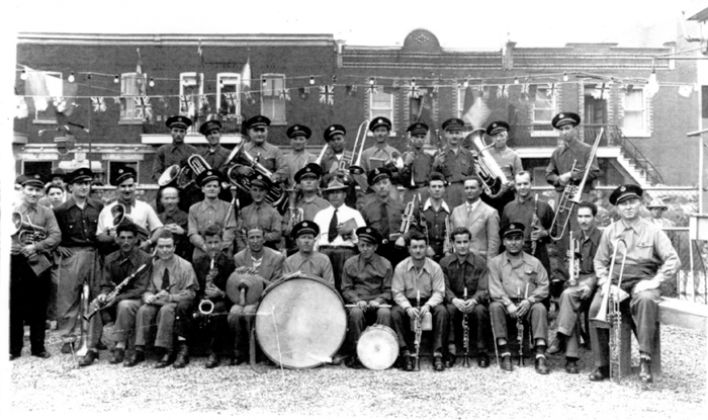Montreal’s oldest Italian organisation, the Order Sons of Italy, is also the city’s oldest Italian band – and they have the photos to prove it!
Joe Fratino doesn’t care much for the spotlight. Even as president of the Order of the Sons of Italy, the oldest Italian organization in Montreal, he usually prefers working in the background to ensure that things get done. But when it comes to this latest project, which consists of a photographic exhibit of the history of the Sons of Italy bands, he is front and centre – and proud of it!
“What first got me interested was seeing this history in music,” Fratino says, riffling through a thick album of photographs that depict the various Montreal Sons of Italy bands from the 1920s to the present day. “But what brought it all together, what made it click for me, was the fact my father-in-law, Gentile Dieni, was associated with the band for some 40 years.
“So it’s a way of honouring him while at the same time honouring the band down through history – and trying to make sure that we don’t forget about these people and what they did. Often in the community at large, I hear people talking about my father-in-law and the work he did. I’m hoping this exposition might be a start so that these musicians become better known and get the exposure they deserve.”
The exposition represents the first project by the Sons of Italy in the Casa d’Italia since the renovation and restructuring of the building. It will feature different eras of the band from 1919, the time of the formation of the Sons of Italy chapter in Montreal, to the present-day performers, led by Beniamino Cinalli.
Along with photographs of the various bands and band members depicting the more than 90 years of their existence, the exposition will feature articles such as hats, uniforms, and old saxophones on display. As well, the present-day band will perform as part of living history.
“On the opening night, November 24th,” Fratino says, “we are inviting some 250 VIPs. When I say VIPs, I mean people from the various groups and associations who used the band, as well as musicians who were involved with the band and then went on to make careers for themselves.
“We will have speakers who will recount the history of the bands, projections of photographs, some videos of my father-in-law, and a 30-to-45-minute DVD video presentation. After that, we will have a small cocktail reception. Following opening night, the exposition will open to the public and continue for a week through November 30th.”
During the week, some of the present-day band players will put in an appearance, in full uniform, serving as volunteers but also performing for the visitors.
“The band is still quite active,” Fratino says. “They recently played at the Madonna di Pompei Church and for the Madonna della Difesa procession. They also put on concerts, with 35 to 40 band members on stage at one time.
“This is the sort of thing I want them to do at the exposition. Come marching in. A couple of tunes. Show the people they’re still going strong. In fact, I’m taking them on our apple-picking excursion on Sept. 25. This will be the 63rd edition of our annual apple picking. We’re expecting about 600 people. A get-together for everyone, young and old.”
One of Fratino’s concerns is that many of the Italian organizations are made up mostly of older people and they need to attract the younger generation if they want to survive. That means changing the way they do things. “When the Order Sons of Italy in New York decided to open a branch in Montreal in 1919,” he says, “it was the only Italian organization. Its mission was to help and protect immigrants, to help them adapt to life in North America, to show them how to become citizens, to offer schooling in English. Even provide immigrants with health benefits.
“Since then, hundreds of associations have been created. The mission of the Sons of Italy has changed over the years. With a greater number of associations, membership lessened and grew older. One of my ideas when I took over as president three years ago was to change our mission.”
One of the ways to do that was to take advantage of the new Casa d’Italia, to use the historical and cultural significance of the building to present an exposition of importance to the entire Italian community – both those who were fairly recent arrivals and those who had been in Canada for several generations. Fratino, who came here with his family in 1952, in the early part of the great post-war wave of Italian immigration, understands the importance of not letting traditions and history fade away.
“The purpose of the exposition,” says Fratino, “is simple. It’s to educate the people, be they Italians or non-Italians. People need to learn the history of the Italians in Canada. The Sons of Italy band is a very strong part of that history. When most people talk about the Sons of Italy, the first thing they mention is the band.”
Although he almost always prefers to work as a volunteer in the background, Fratino does have some experience putting together expositions. “I did one about 15 years ago at the old Casa d’Italia,” he says. “We had a TV show at the time. I went on TV and asked people to send me pictures of couples who had married at the Casa. I didn’t get pictures – I got entire albums! From 1946 to 1972.
“I got a bunch of wedding and immigration and Casa pictures. These were combined with some photographs the city of Montreal had of an exhibit they had held in 1993 on the Italian community. I filled the entire hall with my pictures and those from the city.”
Even before the first exposition of the Sons of Italy band is underway, Fratino already has some ideas for a second exhibit. “I’ve got ideas for two new projects,” he says. “One would be a follow-up on the Sons of Italy bands. It would consist of the various musicians who came out of the bands and went on to make a career for themselves in music. Interview those who are still alive and get images and film of those who are no longer with us.
“A second idea is to do something on the Sons of Italy organization itself from when it was first formed in New York in 1905 through today. Putting together the story of New York, Toronto, Hamilton, Montreal, etc. Show how the organization started and what it went through and how it has come out of it. After all, we now have a brand-new cultural centre here. This Casa is a place where history should be shown to the public.”
In the meantime, Fratino and his fellow Sons of Italy staff members are busy making their way through hundreds of images that represent priceless memories.
The exhibit on the Order Sons of Italy bands will take place at the Casa d’Italia n Montreal from November 24th to November 30th, 2011.
Michael Mirolla is the award-winning author of Berlin, and The Facility (which features cloned Mussolinis), as well several collections of stories and poetry. A novella, The Ballad of Martin B., will be released this fall.
First published in Accenti Magazine Issue 23.



